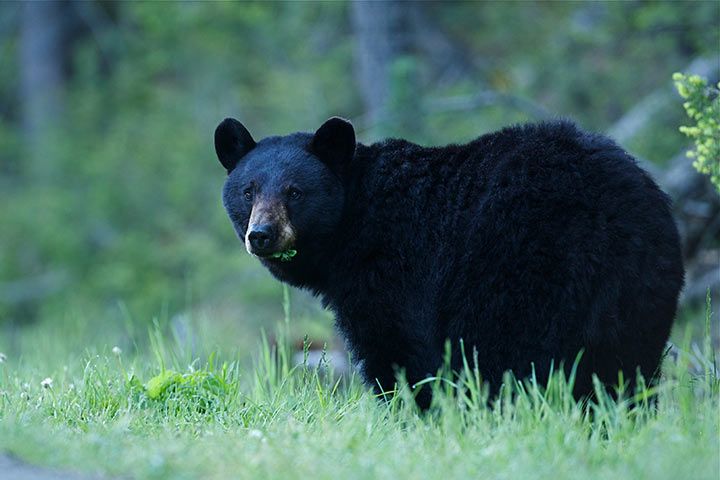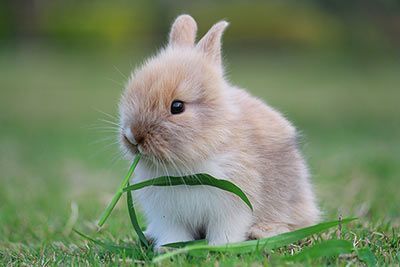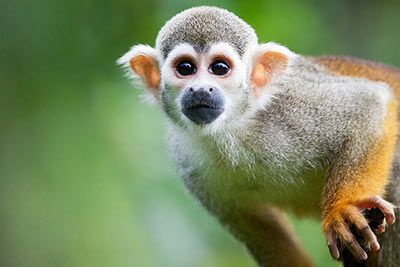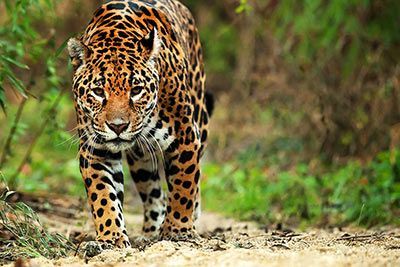Black Bear
Black Bear Facts
| Size | 60-70 in (150-180 cm) (body); 35 in (90 cm) (shoulder height) |
| Speed | 31-34 mph (50-55 km/h) |
| Weight | 88-264 lb (40-120 kg) |
| Lifespan | about 18 years |
| Food | Fruit, berrys, nuts, insects, carrion |
| Predators | Cougars, coyotes, wolves |
| Distribution | North America |
| Habitat | Tundra, forest, grassland |
| Order | Carnivores |
| Family | Ursidae |
| Scientific name | Ursus americanus |
| Characteristics | Bear with dark fur, likes to climb |
Main Characteristics
Black bears are predators. Solitary animals, they are active at twilight and night. They primarily live in North America, Alaska and Canada, where they live in forests or rough land with dense undergrowth as well as open landscapes like grassland and tundra. There are 16 different subspecies.

Diet
A black bear’s diet is 75% to 85% fruits, berries, nuts, grasses and roots. They also eat small insects like ants, bees and termites, and carrion.
Behavior
Do They Hibernate?
Yes, black bears hibernate. When black bears hibernate during the winter, they breathe just once per minute and their body temperature is 4-5 degrees Celsius lower. They don’t drink or eat anything during hibernation. They don’t even go to the little bear’s room!
Are They Dangerous?
Black bears are calmer and more reserved than brown bears, but they’re both wild animals at the end of the day. If you threaten them - even if you do this by accident - or otherwise stress them out, the consequences could be fatal. Black bears are very strong and have sharp claws!

Senses and Abilities
Black Bears Have Skills
Black bears aren’t just intelligent, but also very skilled. They can use their paws to open doors and unscrew jars.
Black Bears Have a Good Sense of Smell
Black bears can smell seven times better than dogs.
Can Black Bears Swim?
Yes, they can swim.
Enemies and Threats
Are Black Bears Endangered?
Fortunately not yet.
Species
Is a Black Bear a Darker Brown Bear?
There are many significant behavioral differences between black bears and brown bears. While brown bears are more aggressive, black bears tend to flee and climb trees to get to safety. They really like hanging out in trees: to eat, to relax and to sleep. Adult brown bears are almost never seen climbing.
There are also anatomical differences: black bears don’t have “hunches”, and they have shorter claws, shorter hind legs, flatter foreheads and lighter noses.
Brown Black Bears
But the color of a brown bear’s and black bear’s coat isn’t always different. Only 70% of black bears actually have black fur. Black bears that live in more southern, warmer areas, have lighter, browner coats. Black bears living further north, where it’s colder, tend to have darker fur.
Why? Dark colors absorb the heat of the sun more quickly and store it for longer. Think about how it feels when you wear a dark T-shirt on a hot summer’s day. Hang on! Why is the polar bear white then? Well. Its fur isn’t actually white, it’s see-through. And the polar bear has black skin that sunlight reaches by traveling through the hair.
White Black Bears
It’s no joke: there are actually white black bears! They’re known as “spirit bears”. They’re a subspecies called Kermode bear. Around 10% of Kermode bears have white fur due to a natural change in their genetics (a gene mutation). They’re not albino.





















